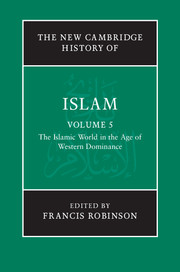Book contents
- Frontmatter
- Introduction
- PART I THE ONSET OF WESTERN DOMINATION C. 1800 TO C. 1919
- PART II INDEPENDENCE AND REVIVAL C. 1919 TO THE PRESENT
- 11 Turkey from the rise of Atatürk
- 12 West Asia from the First World War
- 13 Egypt from 1919
- 14 Sudan from 1919
- 15 North Africa from the First World War
- 16 Saudi Arabia, southern Arabia and the Gulf states from the First World War
- 17 Iran from 1919
- 18 Central Asia and the Caucasus from the First World War
- 19 Afghanistan from 1919
- 20 South Asia from 1919
- 21 South-East Asia from 1910
- 22 Africa south of the Sahara from the First World War
- 23 Islam in China from the First World War
- 24 Islam in the West
- Glossary
- Bibliography
- Index
- References
18 - Central Asia and the Caucasus from the First World War
from PART II - INDEPENDENCE AND REVIVAL C. 1919 TO THE PRESENT
Published online by Cambridge University Press: 28 March 2011
- Frontmatter
- Introduction
- PART I THE ONSET OF WESTERN DOMINATION C. 1800 TO C. 1919
- PART II INDEPENDENCE AND REVIVAL C. 1919 TO THE PRESENT
- 11 Turkey from the rise of Atatürk
- 12 West Asia from the First World War
- 13 Egypt from 1919
- 14 Sudan from 1919
- 15 North Africa from the First World War
- 16 Saudi Arabia, southern Arabia and the Gulf states from the First World War
- 17 Iran from 1919
- 18 Central Asia and the Caucasus from the First World War
- 19 Afghanistan from 1919
- 20 South Asia from 1919
- 21 South-East Asia from 1910
- 22 Africa south of the Sahara from the First World War
- 23 Islam in China from the First World War
- 24 Islam in the West
- Glossary
- Bibliography
- Index
- References
Summary
The indigenous peoples of Central Asia and the Caucasus underwent profound changes from the First World War to the early twenty-first century. They experienced wars and revolutions. The states in which they lived broke apart, reassembled in a different way, and broke apart again. Their perceptions of who they were, what they believed and what would best serve their interests were in some ways quite different from what they had been in earlier times. Yet they were not completely divorced from what they had inherited from earlier generations, even if they might reinterpret their past in a way that would have surprised their ancestors.
The First World War
Although Central Asia was far from the main battlefields of the First World War, the region’s inhabitants were affected by the conflict, first in the form of an uprising against a military draft, then in the form of famine. Late in the war, conflict spread across the southern Caucasus to the territory that would become Azerbaijan.
Wartime demands imposed heavy burdens on many inhabitants throughout the Russian empire. For Central Asians these took the form primarily of increased taxation and the requisitioning of livestock and carts as Russia’s transport system neared collapse. That caused considerable hardship, especially for those peoples whose livelihood centred on animal husbandry. For the Kazakhs the problems were compounded by Russian officials’ seizure of Kazakh lands and bad weather, which took an additional toll on their herds.
- Type
- Chapter
- Information
- The New Cambridge History of Islam , pp. 517 - 541Publisher: Cambridge University PressPrint publication year: 2010

